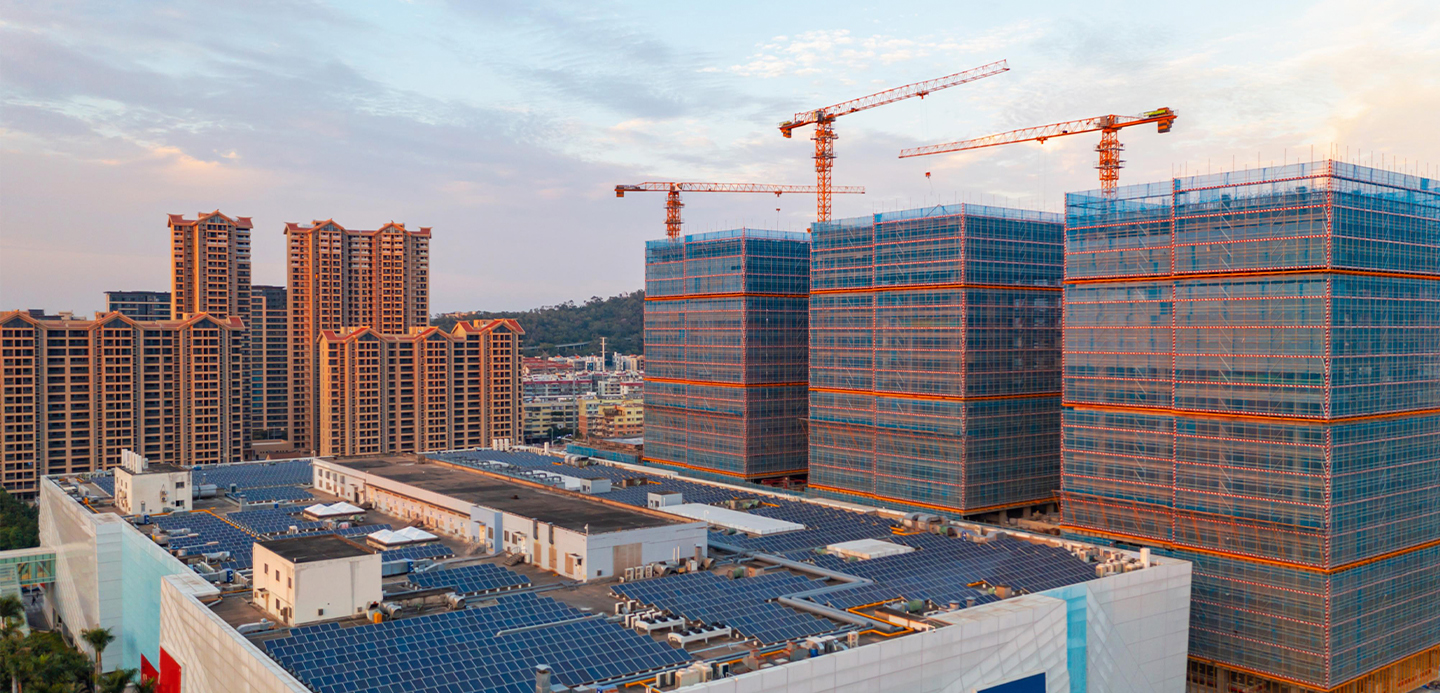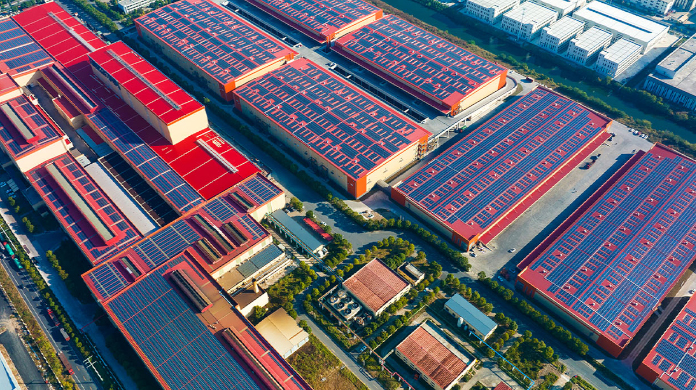- Article

- Infrastructure and Sustainable Finance
- The Future of Infrastructure
How climate tech innovation is transforming the built environment
Corporate real estate developers and managers face rising costs, as well as challenging emissions reduction targets. Innovative start-ups offer a new wave of solutions.
Key takeaways:
Property developers, managers and construction companies want to cut costs and carbon emissions, but existing solutions can only get them so far
The sector emits the second-most carbon emissions after energy, and construction costs have risen over the past decade¹. But new technology and data-driven innovations are reaching commercial scale and can help reduce both.Start-up innovators are often able to offer proven solutions but need strong partnerships with corporate customers to be able to scale
For start-ups, funding and achieving technological and scientific breakthroughs are just the initial challenges. They then need to secure more investment and cross the scale-gap to commercialisation. Corporate customers who are willing to try novel solutions are essential to their success.Connecting cutting-edge innovators and corporate customers is a key role for HSBC
The solutions emerging today are exciting but identifying which to explore can be difficult for corporates. That’s where HSBC can play a key role, by bringing together innovative start-ups with established companies to find the win-wins.
From cement made from industrial waste, to insulation made from fungi, to a pioneering database that optimises the path to net zero for all 29 million properties in the UK - innovative start-ups are finding ways to meet the decarbonisation challenges facing owners and users of real estate today.
Businesses in all sorts of sectors are looking to mitigate rising operational costs as well as make their property stock more efficient from an environmental perspective. Climate tech start-ups are rethinking traditional methods to help them achieve both objectives, opening up exciting new opportunities for clients to improve both their business and the planet.
The UK is a particularly bright spot for the innovative solutions being developed by climate tech startups, with climate tech investments rising 24% to £4.5 billion ($6.1 billion)2 in 2024. And as part of London Climate Action Week 2025, entrepreneurs presented a range of these innovations at an event co-hosted by HSBC and Carbon Limiting Technologies.
Cutting-edge technologies driving change
Companies are helping by identifying specific pain points within the corporate built environment and developing products that perform better as well as reduce the overall environmental footprint.
“This is a win-win for clients today,” said Matt Hessey, Senior Manager at HSBC Corporate and Institutional Banking. “By partnering with innovators that are producing cutting-edge environmental technologies, companies are able to benefit from improved efficiency, lower costs and contribution towards their own climate goals.”
Take concrete: developers can rarely avoid using it in construction, but it is a considerable source of emissions and often accounts for about half of a construction project’s emissions3. That’s largely because it contains cement, which alone accounts for some 30% of building materials’ emissions4.
Material Evolution is pioneering a process to manufacture ultra-low carbon cement out of industrial waste feedstocks, thus contributing to the circular economy while also cutting emissions by up to 85% compared to traditional cement production5.
That saving is mostly down to the fact that the company’s process needs no heat – its 120,000-tonne Mevo A1 Production Facility is able to operate at ambient temperatures rather than the typical 1,500 degrees – so energy consumption is dramatically reduced.
“Concrete is the second-most-used material in the world after water,” explained Elizabeth Gilligan, Material Evolution’s Founder and CEO. “It accounts for 8% of global CO2 emissions6, and most of that is from cement production.”
Material Evolution’s solution combines artificial intelligence with cutting-edge chemistry to produce MevoCem, a cement that matches industry-standard strength while lasting longer and performing more sustainably. It’s an example of how innovators are using a drive to improve environmental credentials as a means to improving performance more broadly.
Tim Lord, Head of Climate and Energy at HSBC UK, stressed the crucial innovation role that such start-ups can play in meeting the needs of the building materials and property management sectors.
“We have many of the technologies we need for the transition, but innovation can help us do them better – improving outcomes and cutting costs” he said. “We can help companies in all sectors cut their emissions in a way that both delivers environmental outcomes and supports the bottom line.”
Less can be more
A combination of increased materials costs7 and more ambitious environmental targets is encouraging developers to make materials go further. Minimass is responding to that demand by designing structural beams and frames which use around half as much material as traditional concrete or steel options.
Co-founder Sarah Blake said that minimass beams provide equivalent performance and spans as conventional concrete or steel, but are up to 40% cheaper, with 50%-78% less embodied carbon8. This is achieved by rethinking the design and the manufacturing process, combining precision technology in the form of 3D concrete printing with post-tensioned steel.
Improving the design of buildings to make them more suited to changes in environmental conditions inevitably means that insulation is a priority – both to retain heat and to keep it out. The challenge is how to respond to that increased need without creating a new drain on environmental resources.
In another example of a circular economy approach to climate innovation, Biohm is creating insulation by combining mycelium, the thread-like roots of mushrooms, with agricultural or industrial waste. Founder and Chief Evolution Officer, Dr Ehab Sayed, highlighted that not only is this insulation regenerative, but its manufacturing model also addresses the known bottlenecks faced by alternatives which are threatened by supply chain volatility.
“You can go anywhere around the planet and use agricultural waste to meet the insulation market’s quantities,” he said. “It’s regenerative – and it’s significantly carbon-negative.”
Data matters, too
For many owners or operators of buildings, the priority is reducing unnecessary building costs or understanding the potential improvements that can be made to buildings to make them more efficient. That’s hard to do without the right data: many UK energy performance certificates (EPCs) rely on data from a methodology designed in 2012 and are not reflective of recent decarbonisation progress, thus making it difficult to assess accurately the cost of retrofitting.
That’s where a company like Kamma Climate comes in. Kamma compiles millions of datapoints from datasets that cover UK buildings, including from utility companies and satellite imagery, into a comprehensive property database covering the whole country. It runs a cost optimisation to model the best fit improvements and ideal energy profiles, providing owners with objectives for improving performance and efficiency – useful at a time of rising regulatory standards.
Residential landlords face a big challenge, as do corporates: “As many as 58% of UK rental properties will be deemed illegal to let from 20309 under proposed EPC rules,” said Neil Sampson, Chief Product and Innovation Officer at Kamma. “For corporate owners of real estate it also means new compliance duties and reputational exposure. There’s been an explosion in demand for high-quality property data, but the supply of that data is fragmented and non-standardised.”
The retrofitting needed to improve energy performance is also in focus for innovators, as technologies such as AI offer new ways to drive potential environmental efficiencies. Dan Williams, CEO of measurable.energy, is focused on using AI-assisted power sockets to automatically detect and control plugged-in appliances to automatically eliminate any wasted energy.
The company says Mexican dining chain Tortilla reported a 32% energy reduction after installing the sockets across its retail kitchens10. Williams demonstrated that commercial real estate and temporary buildings on construction sites could cut their energy output costs even more.
Jade Cohen, Co-founder and Chief Product Officer of Qflow, explained how her company uses an AI programme to analyse photos of delivery tickets for construction goods, to spot where they do not match the initial order. Doing so can reduce costly mistakes and the related carbon emissions that come from fixing them.
“You have direct financial cost savings; with automated data collection you can avoid the risk of things going wrong during the programme and having to do the associated rework,” she noted.
From seed to scale
Companies like these are already commercialising their products and services. Now they are looking for partners and customers to scale their businesses further.
Ben Lynch, Chief Commercial Officer at Carbon Limiting Technologies, a climate tech-focused innovation consultancy, noted the importance of corporate partnerships in fostering and supporting the kind of innovations being developed by these companies.
“The challenge of bridging that commercialisation gap is how you move the perceived risk, which the first set of funders are more willing to take, and create certainty for the other partners,” he said. “We see the role of corporates in bridging that gap as being critical for the growth of the market.”
Bringing innovators together with international investors, corporate clients and off-takers is a critically important step in taking these emerging technologies to the next level of efficiency and sustainable cost. Solving for net zero requires actions on a commercial scale.
This is one area where HSBC is well positioned to help businesses make new connections, through the power of its network and its Innovation Banking franchise.
“It’s about connecting innovators with people and companies who are hopefully going to deploy those innovations across their businesses,” said Lord. “That is really going to help scale these technologies and, ultimately, reduce emissions.”
- https://www.ukfinance.org.uk/news-and-insight/blog/evolving-cost-construction-in-uk-trends-challenges-and-future-outlook-0
-
PwC, UK climate tech investments surge almost 25% (December 2024)
-
https://www.weforum.org/publications/scaling-low-carbon-design-and-construction-with-concrete-enabling-the-path-to-net-zero-for-buildings-and-infrastructure/#:~:text=Buildings%20and%20infrastructure%20are%20responsible,7%25%20of%20global%20carbon%20emissions.
-
Material Evolution, Ultra-low carbon solutions
-
World Economic Forum, Cement is a big problem for the environment. Here’s how to make it sustainable (September 2024)
-
UK Finance, The evolving cost of construction in the UK: Trends, challenges, and future outlook (2024)
-
LandlordTODAY, One in 20 landlords is ignorant of their property’s EPC rating(January 2025)
-
Measurable Energy, Tortilla wraps up plug power savings with measurable.energy
The information contained on this website is provided for informational purposes only, and does not constitute an offer to sell or the solicitation of an offer to buy any products referenced. Eligibility criteria and T&Cs apply for the products referenced. Local country restrictions and limits may apply. Please speak with your HSBC representative for more information.
Further Insights



